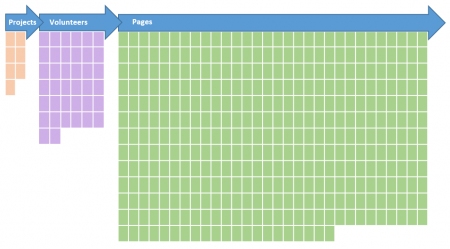When it comes to the Smithsonian Transcription Center, there’s always more to discover, more material with which to engage. It can be easy to lose track of just how much our crowd of #volunpeers accomplished and why it is so important to us. We’re not done yet, but after four years, it’s a good time to take a step back and see what has been accomplished through the effort of over 3,700 volunpeers working on the Archives’ documents.
What’s in a name - #volunpeer
When the TC launched in 2013, we had notions about who might come to work on the projects the Archives and other Smithsonian divisions put online. Honestly, we didn’t expect the volunteers who came to represent such a broad range of interests, experience, and age groups. The dedication they have shown is exemplified by the lesser known people, events, specimens, and the connections between them that they have surfaced. And it does not stop there. In short, we found a community of peers, ‘birds of a feather,’ in our mission to increase and diffuse knowledge. Hence the Twitter hashtag #volunpeers.
Measuring the impact: By the numbers
The number picture below is the easiest to draw an impressive in its own right. I’ve grouped some of the projects into a few topical categories in an effort to open a window on these successes. But first, the numbers …

The sheer numbers are impressive: over 3,700 registered volunpeers have completed over 700 projects, transcribing and reviewing over 38,300 pages of material.
Enabling in-depth access to content
A global audience
However, numbers don’t reveal the true value of the accomplishments this partnership has created and continues to create. The accessibility these efforts have made possible is extraordinary. Instead of the viewing the documents in person at the Archives as was the case years ago, the latest combination of digitization, online access, and in-depth searching opens up a new realm of possibilities. Transcription makes that in-depth searching a reality. Warning: what follows might seem like a lot of content despite being a partial listing. We are grateful to all the volunpeers who helped make it so!
A global scope of material
The Smithsonian’s early emphasis on scientific research led to assembling a national collection with which to facilitate that work. To that end, second Smithsonian Secretary Spencer Baird corresponded with people around the globe in this pursuit. His Index of Correspondence is geographically organized and documents relationships around the world with many of the individuals whose works or specimens our volunpeers transcribe such as Vernon Bailey, William Dall, Robert Kennicott, Benjamin Dann Walsh, C. Hart Merriam, and Frederick W. True. The United States National Museum’s Curators Annual Reports capture how curators sought to collect and distill the new information that was pouring in.
Work by geographical region
Alaska and the Pacific Northwest (33 projects)
- Leonhard Stejneger
- Martin W. Gorman
- Frederick W. True
- George Gibbs
- Albert Spear Hitchcock
- William H. Dall
North America (263 projects)
- Florence Bailey
- James Eike
- G. Arthur Cooper
- Constantine Rafinesque
- Robert Ridgway
- William Henry Holmes
- Bohumil Shimek
- Albert Spear Hitchcock
- Alexander Wetmore
- Harrison G. Dy
- Vernon Bailey
- Frederick Colville
- Ira Gabrielson
- Charles Walcott
The Caribbean and the West Indies (17 projects)
Central and South America (69 projects)
- Martin H. Moynihan
- Cleofe E. Calderon
- Mary Agnes Chase
- Doris Cochran
- Ellsworth Killip
- Albert Spear Hitchcock
- Alexander Wetmore
- Waldo Schmitt
Europe and the UK (13 projects)
Africa and the Middle East (9 projects)
Asia (23 projects)
Antarctic and Oceania (6 projects)
Completed online transcriptions make it possible for researchers, scholars, and scientists to use data mining techniques to first, locate appropriate primary sources, and then analyze that material. We are excited about the prospects of this continued collaboration in the months to come. As #volunpeers remark on Twitter, #welearntogether.
Related Resources
- Field book posts on The Bigger Picture blog.
- Baird’s Network, Bigger Picture blog.
- The Field Book Project blog.
Related Collections
The links in the groupings above lead to the Transcription Center which will in turn link to collection finding aids and catalog records. Another way to find these resources is to search our collections here.
Produced by the Smithsonian Institution Archives. For copyright questions, please see the Terms of Use.

Leave a Comment